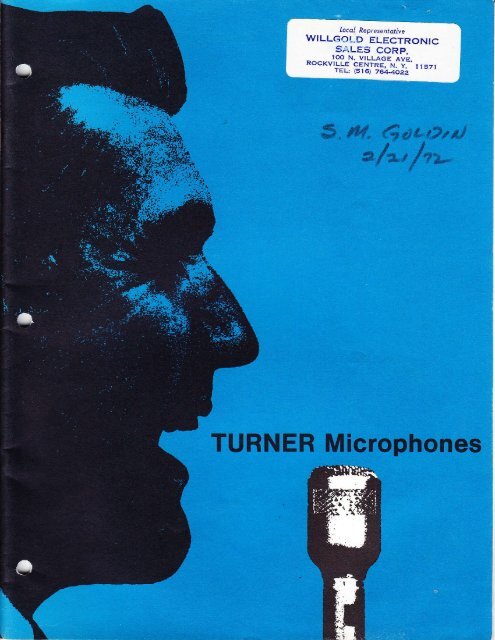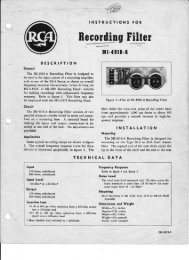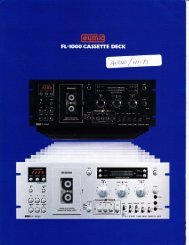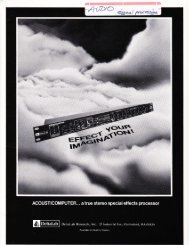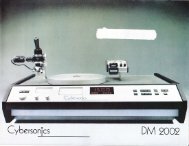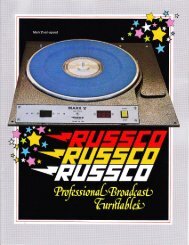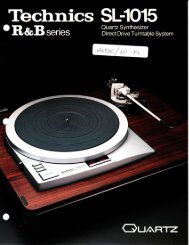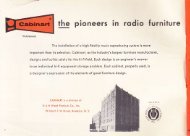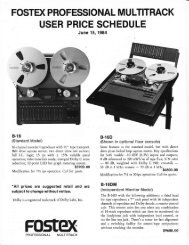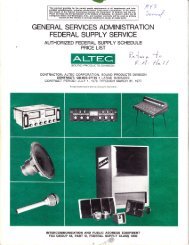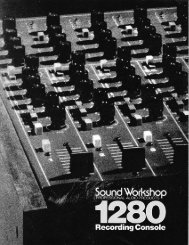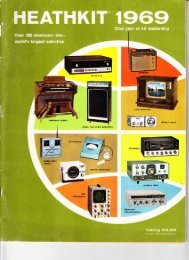Turner_1970_catalog1 - Preservation Sound
Turner_1970_catalog1 - Preservation Sound
Turner_1970_catalog1 - Preservation Sound
Create successful ePaper yourself
Turn your PDF publications into a flip-book with our unique Google optimized e-Paper software.
IITHE TURNER COMPANYSince its founding in 1931, The<strong>Turner</strong> Company has kept pacewith and provided leadership inthe development of microphoneswhich meet the challenge of adynamic electron ic industry. lnaccomplishing th is. our eng ineering,production and test facilitieshave been continually expandedand refined to provide our customerswith q u ality microphonesat fair prices. Today, the <strong>Turner</strong>plant and laboratory is equippedwith the most modern test andmeasurement f acijities, includ ingthree anechoic chambers.The entire <strong>Turner</strong> facility exists[or iust one ourpose-the oesign.marufacture and sale of microphonesand related products. Ourconfidence in our products isreflected in our f u ll-year.warrantyand fully supported by our customerservice department,ln addition to our <strong>Turner</strong> brandline of microphones, for manyyears <strong>Turner</strong> has been a contractsupplier of microphones to manywell-known industrial and manufacturing firms-in the aggregatetotaling many hundreds of thousandsof microphones. ln eachsuch case, the microphone wasdesigned and built to the customer'sexacling requirements forperformance and environmentalreliability. Many of these customershave their own acoustictest f ac ilities and constantlymon ilor microphone perf ormance-ourreturns have bee ngrat.fyingly low. lnquiries are invitedf rom manufacturers needinga microphone to completetheir product package.!
How to choose a microphoneTo help you find the one best microphonefor your specific use, the catalogis divided into sections, as listed in thetable of contents on the opposite page.These sections are based on yourappl cation rather th an our d esig n.Within each section, the microphonesare individually different and these differencesare fully explained. There are,however, a number of basic pointsabout microphones in general whichmay be of help in your seleclion, andthese poinls are brielly covered in thefollowing parag raphs.SensingEvery microphone has a sensing element,or transducer, to convert soundvibrations into electrical signals. Somenic'ophones rave carbon interio rs.some ceramic, ribbon, capacitor, crystal,or dynamic. Each has a use and<strong>Turner</strong> manulactures almost every kind.Mlcrophones utilizing the moving coilprincipal are crassif:ed as dynamicmicrophones. This word is used toidentify the type of construction, hence,either omni-direclional or uni- d ireclionalTicrophones'nay be dyna mic.The moving coil construction producesrugged, dependable microphonescapable of smooih, peak free performance.For broadcast, slage, recordingand public address applications, adynamic microphone g e nerally provideslhe best combination of stability,fidelity, and ruggedness required. Forrnobile ard base station communicationssystems primarily involved withvoice lransmission, ceramic interiorso{fer good thermal and humidity stabilityand satisiactory response in thevoice frequency range. A crysial interioris similar in construction to aceramic offering slightly more outputlevel but is considerably more susceptibleto damage from physical abuseand temperature and humidity conditions.A carbon interior, similar to thoseused in telephones, oilers a ruggedinterior lor relatively low fidelity applications.Frequency ResponseFrequency response describes themanner in which a microphone responds.to sound that it is exposed to.N4icrophones are deslgned to cover aspecific response range with upperand lower frequency limits. Generallyspeaking, microphones are des gnedwith consideraiion glven to the frequencyresponse requirements of typicalapplicalions. For straight voicecommunication, a limited frequencyresponse range of 350 to 3,000 cyc esis pre{erred. For recording applications,often the frequency range mustbe extended to the limjts o1the averagehuman ear or lrom 40 or 50 Hz up to12 to 13,000 Hz. Recording of a symphonyorchestra would require use ofa microphone with an extended responserange of from 40 Hz up toperhaps 15,000 Hz. Generally, extensionof the lrequency range increasescost so there is no economic or audiovalue in using a microphone with agreater response range than you require.For good {ide1ily, the responseover the frequency range must be flat,with no distortion at either end. However,in many appliaations the frequencyresponse of a microphone mustbe tailored to fit the application andthis is taken into consideral a- - -:desigr o'tl-e ricropho-€: - '-:cataiog.Pick-up \-V crophones are des gleo i: :':. ::speci'ic directional cra.ac::' -'- : =Omn i-d irect'o.tal m c'opho-e-, :': - -crophones that are eqLa y s?-,: : . : :soulds arriving fror'r a oi'ecl ---: =-:uni-directional orcardioid m c': : - : -=iare designed to be more ser: .: -:sounds arriving from the f .oni ;- -- : i:serstve 10 sounds ariv ng [':- --:rear o' the r'ricrophone. For sc -: :performance situations cardioiC - :':-phones can be very helpf-l ^ e - -:-'-ing feedback howl and squeal r'. :- :caused by'he mjcrophones oicn -=--:audience, background, and sp::.:-noises and sending them throug- :-.system again. The cardioid or -::-shaped pick--p pattern elinina::-" - -greatly reduces ihe pick-up of sc--,-.arivi'rg f.om the rear of tr're r:-:-pl-o.le. Tl^e shaping of the p c,- - rpatterr is accomp'ished by intE'.'damping or baflles. Every sing le Tu'!ca'oio d m crophone is indiv.o-:resreo for 'ront-to-back discr r -=lioroefore leaving the facrory. ::-sponse curves are charted on ea:-m crophone's performance. lf both:-:fronl response and the cancellatjor :'sound arrlving from the rear do :::Teer spec 'icat ons. il is 'ejected ----rer does ^ot 'nake seconds (even '.-'prvaie labe s). All <strong>Turner</strong> productjcrJstpass ''gio q-ality cottrol reou :--errs oefo'e ii is a,lowed io ea.;our plani.lnput and Output[,4icrophones are a component parl:'an audio system and must be eleci'cal y compatlble with the other sysiecol-'rponenLsN,4icrophones co"le -low impedance (150 ohm) or high ,--pedance (40-50,000 ohm), or in co--binat ons of both. lt is very imporl.that you select a microphone with :Vp'oper in pedarce to malch the rr;cr:-phone inpJt 01 yoLr eqdipment. Ve-.of the microphones in thls catalog a-:
available in either high or low impedanceor combinations of both, takinginto consideration lhe varied impedancerequirements of typlcal applica-Output levels are an indication ofthe oudness. or se.]sitivily ot a mic.ophoneand are measured in decibels(db). This figure is presented in relationto 0 decibels, so a minus numberis used since the output of an unamplifiedmicrophone is many declbelsdb indicates!.ons.below 0. A rating of-54a higher output level than one shownat-60 db.Microphones in this catalog havetheir sensitivity specified in two ways.The first gives the ouiput voltagefrom high impedance microphones indeclbels below 1.0 volt for an appliedsound pressure of 1.0 microbar, withno load connected.The second gives the power developedin a matched resistance load interms of decibels with reference io 1.0milllwaii when I0 microbars of soundpress-re are appl,ed. Th s rating is. irgeneral, most useiul with low imped-9)ce m icrophones.StylingSty ing is a very important consideraton ln the selection of a microphone.This is one reason we have so manyllsted ln this catalog. lf you want amicrophone for a check-out stand, youprobab y want it on a flexibie goosenec{lsee Model SR585D on Page 19),: yor.r want a mobile microphone for\i.-t cat. you want one that jits nicely' ,: -' 'a'rd (see mobile communicatic.sn crophones, Pages l0 and 11).PerIaps you want a rugged metalm J.oohone with a ball screen head forstage v/ork (see our 700 series, Pages6 ano 7r. or a light plastic one for taperecord ng isee Pages 14 and 15). Perhapsyo,r u ant it s lver or goTd or blueo. blac, 'ro- 'e goi-g 10 use a microphonedon r be shy about styling, get<strong>Turner</strong> wi ch you be proud to own\hd happy :o -se Serect the microphonewh ch gives you the best combinationof styling. performance andreliabil iy for your money.Professional Recording,Broadcast, Public AddressCardioid Dynamic Microphones500 Series,Table of ContentsPag eProfessional Standards . 4 & 5600 Series.Economy Cardioid ..6&7700 Series,Ball Screen Styling .6&72203, Professional StyledCardloid........6&7Dynamic Omni-di rectionalMicrophones35 Series, IVini-Mike Lavaliers I2300 Series,Professional Styling . 8Balladier Musician's CardioidDynamics, with carrying casesN.4odels 566, 766,866, 2266 . . . IMobile CommunicationsM icrophonesStandard Line360Series.350C and 355CSR90D Series .TransistorizedM*2U Serlesf350Series..10&11..10&11Base Station CommunicationsStandard Line254 Series ...12&13454 Series ..12&13754C- New Style Ceramic10&1110&1110 & 11Base Slation 12 & 13Transistorizedl\,lodel +2Nlodel +3Page..12&13..12&13Tape Recording and GeneralPurposel',4odel 2800 and 2804Stereo Pair . 14&15Models 281 1-14, CassetteReplacements ...14&15[,4odel 304, Ceramic,304X CrystalNlodel S2850,14 & 153-in-1 Dynamic. . . . 14 & 15Paging, Public Address andGeneral Purpose250 Series, desk model . . . 16 & 17750 Serles, desk model . . . 16&17N,,lodel +50 Transistorized 16 & 17SR585D Gooseneck 18 & 19l'4odel SR70D, Mobile . . 18 & 19Model 58, Lavalier 18 & 19Model 33D,iVodel P-9D,Stand l\,4icrophone. . 18 & 19Mobile Nlicrophone 18 & 19N,,lodel 3561 4, PortableP.A. l\licrophone . . 18&19N/odel 360-04,P.A.Microphone . . . . . 19StandsCartridgesAccessories.....20&21. . .20&21. .20&21
Professional Recording, Broadcast, Public Address<strong>Turner</strong> 5OO Series, Dynamic Cardiod Microphones{i<strong>Turner</strong>'s 500 series microphones arespecified for many diJficult applicationswhere background noise creates a problemand where extreme fidelity of reproductionis required. They have a widerange, smooth response. Uniformity ofperformance, microphone to microphone,is assured by a series of intensive checksand tests during manufacture, includingcomprehensive response measurementafter fina' assembly. Each microphone isindividually adjusted during tests I The resultis a cardioid pick-up pattern such thatsensitivity to sounds arriving irom the rearis minimal; front to back discrimination isunmatched in the industry. For criticalapplications where Jeedback is a problem,the 500 series, due to its exiremely uniformresponse and excellenl fronl to back discrimination,will provide more usable gainbefore Jeedback.lnternal screening and baffling substan-'tially reduces unwanted noises and popsJrom wind or explosive breath sound duringclose-talking use. Rubber shock mountingis used to reduce mechanically transmittedshocks, jars and handling noises.Styling is attractive, construction isrugged, and the satin chrome Jinish isdurable and easily kept clean, For churchinstallations, the 500G and S-500G in goldfinish are available.MODEL 510 ON C-7 STANDIV1ODEL FM5OOI{II;it{:*MODEL S-500-06 I\iIATCHED STEREO PAIRMODEL 5OO ON G-12 STAND I\4ODEL 505Typical Microphone Response CurvefREQUENCY IN qYCLES PER SECONDMODEL 777
Specif ications, 500 SeriesType: Cardioid dynamiclmp€dance: 150 ohms (matches 50to 250:.': in puts) or high impedance (40,000\r :--r-s) selected at the terminal end of:.3 cableOutpui level: H igh impedance55 Cb (0 : 1 volt/microbar):50 ohms57 db (0 : 1 mw./ 10 microbars)Frequency response: 40-15,000 HzDiscriminalion: Typically 20 db to 25 db.,,er the frequency rangeConnector: 4-pinCable: Detachable, 20-loot, three -con-Cuctor, shielded, black PVC jacketCase: Die-cast zinc alloy, satin chrome:.,r shD ime nsions: 6-13/16tt lenglh, 1-17 /32t1a'enreter't.eight: 12 ounces, without cable. Ship-3 rg weight, 3 poundsA I models except the FN.4500 are sup-: :r \Yth rugged Cycolac swivel stand...2.'ct 5- /gtt-27 lhread.Model 500:: sled ln the specifications, without on-V"..'. ich.Model 5-500With Rotary On-Off Switch-:- la- lo rl'e Nlodel 500. br,l with a posi-: .:-action rotary switch and clearly iden-:':: rosii ons.Model 5-500-06',iatched Stereo Pair-:-::-: Jr formity of the 500 microphones. ',:-:' -croved by careful seleclion to_'.': :: . oi 5500's so closely matched in::-: : . :, end frequency response they,. :--:-:e anystereosystem.Withstand-: -' I -_-.6^ldcModel 505Combines the superior cardioid features ofthe l\,4odel 500 with the acoustical advantagesof an adjustable bass response. Bassresponse is controlled by a rotary switch,marked "normal" and "less bass." Frequencyresponse is 40-15,000 Hz in "normal"position, 100 to 15,000 Hz in "lessbass" position. Bass roll-offis helpful whenihe microphone must be used close to theso-10 source, e ther the speaking or singingvoice.Model FM50OFixed MountThe new Flvl500 series includes a switchand a non-switch model. A Model 500microphone is permanently mounted on acouoler assembly and's excellent for usein churches, schools and auditor'ums forfixed mounted applications, or wheremicrophone theft could be a problem. Low(150 ohm) impedance only, -57 db outputlevel, with Amphenol PC3F 3-pin connector.All other specilications same as Model500. Specify Model 450200 with switch and450201 withoLt sw'tch.Model 510Built to exacting slandards in the <strong>Turner</strong>engineering lab, the 510 is recornmendedby audio consulting expeats for use withnotch-f lter sound systems because ot theflatness of response the uniformity oi frontto back raiio across entire frequency rangeand the un formity achieved n productonfro.r one J'rit 10 a- otFe - of r-ese ' re r c rophones.The N4odel 510 s exceptionally flat'esponse ove. t.e 40-15.000 -lz rarge .slllustrated in the accornpanying chart. Lowi.npedance only 50 or 200 ohms may bechosen at the lerminal end of the cabLe.Finished ln non-reilective broadcasl gray,shipped wilh desk stand, Cycolac standadaptor, and broadcast vJind screen. Shippingweight is 4 pounds.Model 777 Jet StarThe Entertainer's CardioidAll of the acoustical and iunctional featuresmost desjred by entertainers are includedin the Model 777 "Jet Star." True cardioidperformance; excellent ease of switchingfrom hand-to-stand; no extra adaptors tobuy; the best on-off switch, a rotary typethat's clearly marked and easy to see anduse; 100-15,000 Hz frequency responseitailored roll-ofi bass response which perrr:tsclose-10-noJlh use wilhout poppingor breath noise; rugqed all-metal case;detachable cable.Specifications, Model 777Type: Cardioid dynamiclmpedance: 150 ohm (matches 50 to 250ohm inputs)Output level: -56 db (0 : 1 mw./10microbars)Frequency response: 100- 15,000 HzDiscrimination: Typically 20 to 25 db overihe frequency rangeConnector:3-pinCable: Detachable, 20-Joot, th ree- con -ductor, shielded, black PVC jacketCase: Die-cast zinc alloy, satin chromefinishDimensions: 7-1/2" lenglh, 1-17 /32t1 diameterWeight: 12 ounces without cable. Shipplngweight, 3 poundsList Priceslvlodel 500N/odet 500G (gold linish) .Model S-500[,4odel S 500G (gold finish)Model S-500-06Model 505N,4odel F14500Model 510Model 777N,4odel c-7 desk stand[,4odel G-12 floor stand$100.00'1 1 6.00105.00120.00210.00120.0098.00150.00120.0011 .0020.00
Professional Recording, Broadcast, Public AddressLt\,40DEL 2203IMODEL 600MODEL 7OOL
<strong>Turner</strong> 600 SeriesDynamic Cardioidl'\,'!icrophones-- : :., : )sr of tl^ese rrrcropr]ones. whichU:- ; :' - :acrJrceof pe.'ormance, ma{es-:- :- -Jtstardirg va'ue. Response is-.-:r:: and wide-range. lnternal baffling- - - les unwanted wind and breath-: .:s The active element is mounted in.:=^: a rubber shock mounts which effec-: .: .,-eauce noise arising jrom handling,--:: -j and jarring. The directional pjck--: --?'?:re';slic is Jlexcel ed*compar,-:: - ,. i', ried with microphones at any price-=-: is iruly helpiul when dealingwith the:-:::r'rs ol audience or equipment noise:-: :coJSiic feedback::':ciive y styled in salin chrome iinish.-: : ack Cycolac. Has line shorting on-oJf-.,. ::-. Altached cable. All models are:-:: eC yrlth rugged Cycolac swivel stand=aa.a:.'s. YB" -27 lhread.Specif ications, 600 Series;yee: Card ioid dynamici:rpedance: High (40,000 ohms- l\.4odel400) or low (150 ohms-Model 602)Sirtpui level: H igh impedance--5 db (0: l volt/microbar)'5C ohrns-57 db (0 : 1 mw./10 microbars)E:'eoJencyresponse: 50-t 5.000 HZI scr;mination: Typ ca ly 20 to 25 db over:^e irequency rangeaaole: 12-fool, single-conductor, shield-:tr (high impedance); two,conductor,s:-lelded (low impedance)Iimensionst 6" length, 1s/stt diamelerCase: Die-cast zinc alloy, satin finish, Cyccac plastic front.,ieight: 14 ounces, shipping weight, 3::L n ds<strong>Turner</strong> 700 SeriesDynamic CardioidMicrophonesldeal for the perforrnlng arts, lhese ballscreen uni-directional m icro phones findwide use with srnall instrumental and singinggroups. Features of this design are thespherical ball screen, internal wind andbreath pop baffling, rubber shock rnounting,all coupled with wide range responseand trJly el eclive back wave oisc'i-nination.Use them for close-in voice for faithfulbut pop-free reproduction. AII modelssupplied with rugged Cycolac swivel slandadapla t, 5/s | | -27 Ift ead.Specifications, Model 700Type: Cardioid dynamiclmpedance: 150 ohms (matches 50 to 250ohm inputs) or high irnpedance (40,000ohms), chosen ai terminal end of cableOutput level: High impedance-55 db (0 : I volt/microbaoI50 ohms-57 db (0 : 1 mw./l0 microbars)Frequency response: 40- 15,000 HzDiscrimination: Typically 20 db over thefrequency rangeCable: 20-foot, three-conductor, shielded,deldchable, black PVC jacketConnector: 4-pinCase; Die-cast zinc alloy, satin chromeiinish case, bright chrome finish screenDimensions: 6" length, 2" diameterWeight: 20 ounces withoui cable, shippingweight,3 poundsSpecifications, Model 701Type: Cardodcynarniclmpedance: l _oh (10 000 ohms)Output levelr -55 dc (0 : 1 vo t/micro-5ar)Frequency response: 40-15.000 HzDiscrimination; Typ ca iy 20 db over theit^^,^^.,t...- 6Cable: 12'i.oi. single-conductor, shielded,detacnable, grey PVC jacketConnector: Anphenol lvlClF, screw ontypeCase: Dre-cast z nc alloy, saiin chromef nlsh case. brlghl chrome finish screenDimensions: 57r " length, 2" dlameletWeight: 20 oLJ.ces /v tho.lcable, shipp.ngweiqht 3 poundsModel 2203Professionally Styled DynamicCardioid MicrophoneA new dynamic cardioid microphone deslgnedto today's high style requirementswith the excellent performance character.istrcs bL lt i-ro al TJrl^r caroioro dynanicmicrophones. Excellent balance for handhelduse. lt's relatively small and lightweight, yet rugged to stand the day to dayabuse ol professional performers. Thisaltractive mic{ophone ieatures a professionallocking 3-pin connector and all steelcase for years of iroublejree use.Specifications,Model 2203Type: Cardioid dynan'rlclmpedance: 150 ohms/balance line outputOutput level: -57 db (0 : 'l pyy./10 microbars)Frequency response: 50-15,000 HzSwitch: On-oJf line shorting typeCable: 20-foot, 2-conductor, shielded,black PVC jacketConnector: 3-pin, Switchcraft typeCase: lVachine steel, saiin chrome finishList PricesModel 600, high impedance . . . $65.00Model602,lowimpedance . . . . . 65.00l\.4odel 700, hioh/Jow impedance 95.00l',/lodel 701, h;gh impedance only 65.00Model 2203, low impedance . . . 90.00
Professional Recording, Broadcast, Public Address<strong>Turner</strong> "Mini-Mike"LavaliersModel 35 SeriesDynamic Lavalier MicrophonesNo longer ls rt necessary to be lmpededby nakilq do with heavy. clumsy nicrophonesin lavalier applications. These new,very small, light weight microphones aredesigned specifically for lavalier applications,including a tailored response overthe ent re speech ralge with no discr'ninationor distortion. Omni-directional pickuppattern. Lavalier cord and clothing cTipincluded. Desert gold finish.Nilodel G-18 stand adaptor and [,4odelG-16 desk stand are complementaryaccessori-asModel 357a" diameter by 3// length. High-low impedancecombination. 25-foot, three-conductor,shielded cable. Weighs only 41grams (less cable). Output level: Hi imp.-60 db (0 : 1 volt/microbar); 150 ohm*60 db (0 : 1 mw./l0 microbars). Frequencyresponse: 50-12,000 Hz.<strong>Turner</strong> 2300 SeriesProfessional Om n i-d irect ionalM ic ro p honesProfessionally styled, omni -directional,dynarnic recording, public address, andbroadcast microphone. Om n i-d irectionalsound pick-up provides a natural sound,with live presence, particularly desirablefor live recording. Also excellent choicewhen more than one person uses themicrophone at the same time in iiveentertainment siiuations. Small diameter(%") machlned steel case, satin chromeJinish, steel grill-easy to handle, ruggedand durable, will provide many trouble-freeyears of excellent performance. Wide,peak free 50-15,000 Hz frequency response,built-in wind screen to reduce popand breath noise. 56 db output. Detachable2o-foot cable with professional 3-pinconnector. On-off switch. Model 2300 ishigh impedance. lVodel 2302 is lowimpedance.MODEL 23OOModel 35A21/4tt long,s/att diamelet. 150 ohm impedance.Output level:-60 db (0 : 1 mw./10 microbars). 50-12,000 Hz frequencyresponse. Broadcast model, desert goldfinish, chrome grill. 25-foot, two-conductor,shielded cable. Weighs only29grams (lesscable). Packaged in attractive leatherettecovered permanent carrying case.MODEL 35AMODEL 35List Prices[,4odel 35Model 35AModel 2300Model 2302N.4odel G-16 desk standN,4odel G-18 stand adaptors70.00eo{75.0075.007.005.00
Mobile CommunicationsWhen selecting a mobile microphone, lt isessential to consider a model which providesthe impedance, switching capabilitiesand performance characteristics requiredfor proper transceiver operation. <strong>Turner</strong>offers all of the widely accepted typesicrystal, ceramic, dynamic, carbon and avariety of transistorized units in a choice ofstyles in either rugged Cycolac or durabledie-cast zinc alloy with satin chrome finish.All mobile microphones are supplied withs-foot extended coiled cord, dash mountingknob and hardware.The variety of case styles offers the usera choice of sizes, pushbutton or leverswitch action, and a selection ot colors.The transistorized models, with adjustableoutpul, are nearly universal in their applicallon.lncluded wrth each of these microphonesis a booklet which identifies nearlya hundred transceiver models which arecompalible, and detailed wiring instructionsto make the installation easy.|\,4oDEL tV1+ 2/ UMODEL SR-SOMODEL 360MODEL 355CMODEL 35OC10
IIModel 360 SeriesDesigned to provide the convenience ofreduced size and weight in rugged Cycolac;to complement the newest solid stateL:ralsceivers and portable public addresssysterns. Al models have a shipping weightof 12 ounces.tModel 360Ceramic mlcrophone for operation of highimpedance tube type transceivers as wellas medium, 50k ohm transistorized inputs.Wired for relay operation with three-conductor(one shielded) coiled cord. Frequencyresponse of 300-3,000 Hz. Outputlevel:-65 db (0 : 1 volt/microbar). BlackCycolac case.Model J-360For transceivers requiring a ceramic microphonewired ior electronic switching.Model360RCarbon microphone utllizes a rugged telephonetype interlor for maximum outputwith minimurn distortion. Wired for relayswitching with four-conductor (unshielded)coiled cord. lmpedance B0 ohms, irequencyresponse of 200-4,000 Hz. Outputevel:-15 db (0 : 1 mw./10 microbars).Model 360 Lo-ZHigh capacity ceramic microphone fortransistorized transceivers requiring a lowimpedance type of microphone input.Writefor a free listing of sets utilizing this specialm icrophone.Model 350CCeramic microphone oJfers trad itionalmobile styling in the most widely acceptedoriginal equipment microphone in CB communicationshistory. Tem perature stableceramic interior provides compatibility Jorhigh impedance transceivers and portablepaging syslems. Wired Jor relay switchingwith three-conductor (one shielded) coiledcord, irequency response of 80-7,000 Hz.Output level;-.-54 db (0 : I volt/microbar).Charcoal Cycolac case, shippingweight, 1pound.Model 355CCeramic microphone wlth full grip-to-talkswitch for ease of operation. Three-conductor(one shielded) coiled cord wired forrelay switching of high impedance transceivers.Frequency response B0-7,000 Hz.Oulput leveli-51 db (0: 1 volt/microbar).Cnarcoal Cycolac case. Shippingweight, 1 pound.Model 90 SeriesMobile CommunicationsMicrophonesFeatures <strong>Turner</strong>'s slender style zinc alloydie-cast case in satin chrome with exclusivefrolt hanger bution. Relay swilching isaccomplished with professional qualityd rec--acring lea'-lype swrtches. Shippingweight of 1 pound, 6 ounces.Model SR90D-5Dynamic mlcrophone, Hi impedance, frequencyresponse of 200- 1 0,000 Hz. Outputlevel:-52db (0 : 1 volt/microbar).Threeconductor(one shielded) coiled cord.Model SR9OD-6Dynamic microphone,200 ohms impedance.Four-conductor (two shielded)coiled cord. Frequency response 200-10,000 Hz. Output leveli-52 db (0 : 1mw./10 rnicrobars).Model SR9ORCarbon microphone w;th durable teleoho4etype ca'bon interior for rraximur].intelligibility and rnlnimum distortion. lmpedanceB0 ohms, frequency response20O-4,0O0 Hz. Output level:-15 db (0 : 1mw.,/10 microbars). Neoprene jacketed,four-eonduc'ior, unshielded, coiled cord.TransistorizedModel M+2/UTransistorized ceramic mobile microphonecombines the humidity and temperaturestability ol a two-stage silicon lransistoramplifier with a ceramic generating ele-'nent. OutpJt level of the [.4+2/U is controlledby a calibrated ten-position volumeconirol which is located on the upper rearcase housing. N,4 + 2/U's built- jn amplif ierprovides a gain of 15 db over conventionalceramic mlcrophones and is powered bya self-collained 7-vort mercury balte.y.N,4 + 2/U is wired for relay switching withthree-conductor (one shielded) coi,ed cordin a blue Cycolac case. Frequency response300-3,000 Hz. Output level: -33do (0 : 1 mw./10 n crobars). Shippingweighi is 12 ounces.Model JM+2/Ulncludes all the features of the M +2/U ina rnodel wred for lransceivers requiringelectronic swjtching. Write for free bookletdetailing sets compatible with ModelsN,4 + 2/U and JM+2/U.Model +350Transistorized dynamic mobile microphonedesjqned to provide consistent modulationand improved intelligibility as a replacementfor many transceivers which normallyrequire carbon microphones. Two-stagesilicon transistor amplifier is installed in adark gray Cycolac 350 siyle housing witha three-conductor (one shielded) coiledcord wired for relay switching. Frequencyresponse 350-4,000 Hz. Output level:-24db (0 : 1 mw./10 microbars). Shippingweight, 12 ounces.Model J+350lnciudes all the features of the +350 in amodel wi'ed lor rransceive's requiringelectronic switching. Write for a free lis!ing of transceivers which can use Nilodels+ 350 and J +350.List Pricesl\.4odei 360Model J360Model 360Rf,4odel 360 Lo-Z,4odel 350CModel 355CN/odel SR90DN,4odel SR90BN,4odel M + 2/UN,4odel JN,4 +2/Ulvodel + 350Model J +350'17.0021.0018.0015.0017.0045.0036.0045.0045.0040.0040.0011
Base Station Communications<strong>Turner</strong> base station com-nunications nicrophonesare standard equipment in thousandsof installations. The base stationoperator may choose between traditionalcrystal or ceranic interiors, or ceramicinieriors with a transistorized pre-ampliiier.Each model is housed in a sturdy die-castcase, with touch-to-talk switch actuator anda lock-lever for longer transmissions.The transistorized +2 and +3 modelsare particularly appealing to many basestation operalors. ln both models, the adjusiableoutput level makes the microphoneuniversally efficient with a wide variety oltransceivers. Both are wired to functionwith either relay-operated or electronicswitchingsets*a slide switch in the baseof the microphone permits easy selection.The adjustable volume control allows theoperator to speak into the microphone ata greater distance from ihe unit, and provjdesthe capabilityto boost the signal froma fading set. The +3 model adds a compressionamplifier circuit which assuresyou that, with the volume control properlyset, you can vary the distance from themicrophone by a ratio of 6 to 1 and stillmaintain 100 percent modulaiion at alltines, wit.out overr].odulalion -nax imu"nperformance and full modulation are guaranieedby this lvodu-Gard@ feature.Each +2 and +3 unit js packaged withan informative booklet which provides completeinstallation instructions for a largevariety of transceiver models.MODEL +3MODEL 454XMODEL +2MODEL 254Xf.MODEL 754C12


